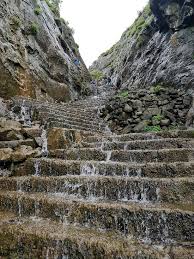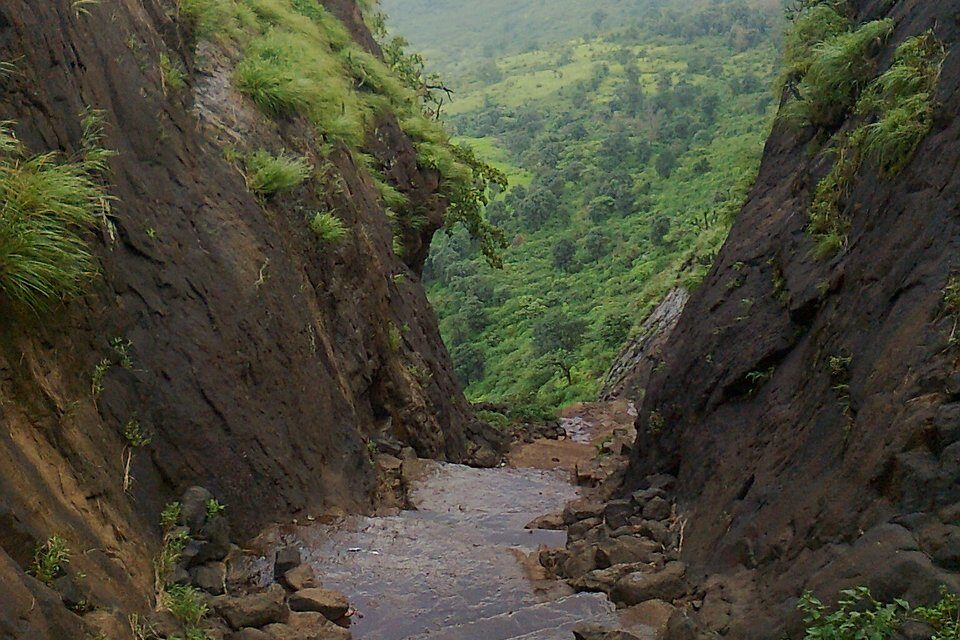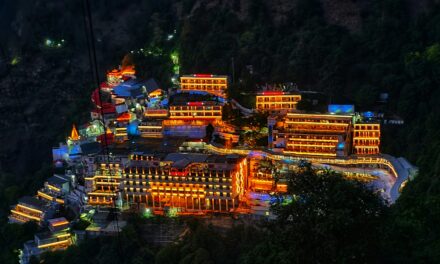Anjaneri Fort

Nestled in the Sahyadri range near Nashik, Anjaneri Fort is a breathtaking destination known as the mythical birthplace of Lord Hanuman. This historical gem offers a perfect blend of spirituality, history, and adventure, attracting trekkers and devotees alike.
The trek to Anjaneri Fort is moderately challenging, passing through lush green landscapes, scenic plateaus, and mesmerizing waterfalls during monsoon. Along the way, trekkers encounter ancient caves, temples, and stone carvings, adding to the fort’s mystical charm.
At the summit, the Anjani Mata Temple, dedicated to Hanuman’s mother, stands as a sacred site. The panoramic views from the top, overlooking the Trimbakeshwar range and Nashik city, are truly awe-inspiring.
Whether you’re a history buff, an adventure seeker, or a devotee, Anjaneri Fort offers an unforgettable experience filled with legends, serenity, and thrilling exploration. A visit here is a journey through time, faith, and natural beauty.
The Mythological Connection of Anjaneri Fort
Anjaneri Fort is not just a trekking destination but a sacred land deeply rooted in Hindu mythology. This legendary site is believed to be the birthplace of Lord Hanuman, one of the most revered deities in Hinduism.
1. The Legend of Anjani Mata & Lord Hanuman’s Birth 🕉️🐵
- According to Hindu scriptures, Anjaneri is named after Anjani Mata, the mother of Lord Hanuman.
- It is believed that Anjani Mata meditated on this very land, seeking divine blessings for a child.
- Pleased with her devotion, Lord Shiva granted her the boon of giving birth to Hanuman, an incarnation of Shiva himself.
- This makes Anjaneri Fort a significant pilgrimage site, especially for devotees of Lord Hanuman.
2. Anjani Mata Temple – A Sacred Shrine 🙏
- Situated atop the fort, Anjani Mata Temple is a sacred shrine dedicated to Hanuman’s mother.
- Pilgrims visit this temple to offer prayers and seek blessings for strength, courage, and devotion.
- The temple’s calm surroundings and divine aura make it a spiritual retreat for visitors.
- The presence of ancient idols and inscriptions adds to the historical and religious significance of the site.
3. Hanuman Footprints – A Divine Mark 👣
- Near the temple, visitors can find mystical footprints carved into the rocks, believed to be those of Lord Hanuman.
- These footprints attract devotees and spiritual seekers, reinforcing the belief that Hanuman once walked on this land.
- The spot holds immense religious importance, with visitors offering prayers and chanting Hanuman bhajans.
4. Connection to the Ramayana 📜
- Anjaneri’s mythological importance is tied to the great Hindu epic, the Ramayana.
- Hanuman, a devoted disciple of Lord Rama, played a crucial role in helping Rama rescue Goddess Sita from Ravana.
- As the birthplace of Hanuman, Anjaneri Fort is considered a sacred site for Hanuman devotees who revere him as a symbol of strength, loyalty, and wisdom.
5. Spiritual Significance & Pilgrimage Site 🛕
- Every year, devotees from across India visit Anjaneri Fort to worship Anjani Mata and Lord Hanuman.
- The fort is especially crowded on Tuesdays and Hanuman Jayanti, when special prayers and celebrations take place.
- Many spiritual seekers undertake the trek to Anjaneri as a pilgrimage, believing it to be a place of divine blessings.

The Thrill of Trekking to Anjaneri Fort
For adventure lovers, the trek to Anjaneri Fort is an unforgettable experience, blending scenic beauty, historical sites, and spiritual significance. The trek is classified as a moderate-level adventure, making it suitable for both beginners and experienced trekkers.
1. Trek Overview
- Difficulty Level: Moderate
- Trek Duration: 2 to 3 hours (one way)
- Distance: Approx. 4 km from the base village
- Starting Point: Anjaneri Village (10 km before Trimbakeshwar)
- Elevation: Around 4,200 feet (1,280 meters) above sea level
2. The Trekking Trail – A Journey Through Nature & History
The trail to Anjaneri Fort offers a diverse landscape, keeping trekkers engaged throughout the climb.
A. Initial Ascent – Walking Through Lush Greenery 🌿
- The trek begins from Anjaneri Village, a small settlement surrounded by farmlands and scenic landscapes.
- The initial stretch consists of gradual ascents, open grasslands, and a well-laid path.
- Trekkers get to witness the rich biodiversity of the Western Ghats, with vibrant flora and rare bird species.
B. Stone Steps & Rocky Sections – A Test of Endurance ⛰️
- After an easy walk, the trail transitions into rocky patches and stone steps, leading towards the fort.
- Some sections of the trail have steep climbs, requiring careful footing.
- Along the way, trekkers pass small caves and ancient carvings, giving a glimpse of Anjaneri’s historical past.
C. Mesmerizing Viewpoints – A Visual Treat 🌄
- As trekkers ascend, they are rewarded with panoramic views of the Trimbakeshwar mountain range.
- The sight of rolling hills, deep valleys, and floating clouds creates a surreal experience.
- On misty days, the entire region feels like a heavenly landscape straight out of a dream.
D. The Final Stretch – Reaching the Summit 🏰
- The last part of the trek includes a narrow trail leading to the fort entrance.
- Upon reaching the top, trekkers are greeted by ancient ruins, a Hanuman temple, water reservoirs, and caves.
- The summit provides a 360-degree view of Nashik, Trimbakeshwar, and the Sahyadri mountain range.

3. Trekking in Different Seasons – What to Expect
Monsoon (July – September) – A Green Wonderland 🌧️🌿
- The entire region comes alive with lush greenery, waterfalls, and mist-covered valleys.
- The cool weather and rain showers make trekking a refreshing experience.
- Caution: Trails can become slippery, so proper trekking shoes and rain gear are essential.
Winter (November – February) – The Best Season for Trekking ❄️🏞️
- Cool and dry weather makes winter the ideal season for trekking.
- The skies are clear, offering uninterrupted views of the landscape.
- This is the best time for photography, sightseeing, and camping.
Summer (March – June) – A Challenging Trek ☀️🔥
- High temperatures (above 35°C) can make the trek exhausting.
- It is recommended to start early in the morning and carry enough water to stay hydrated.
- The landscape appears dry and rugged, but the sunrise and sunset views are still mesmerizing.
Must-Visit Attractions at Anjaneri Fort
Anjaneri Fort is not just a trekking destination but a place rich in history, mythology, and breathtaking landscapes. Here are some of the top attractions that make this fort a must-visit spot:
1. Anjani Mata Temple – A Sacred Shrine 🙏
- This ancient temple is dedicated to Anjani Mata, the mother of Lord Hanuman.
- It is believed that Lord Hanuman was born at Anjaneri, making this site highly sacred for devotees.
- The temple is a peaceful place where visitors offer prayers and seek blessings.
- A great spot to experience spirituality amidst nature’s beauty.
2. Caves and Carvings – A Peek into the Past 🏛️
- The fort has several rock-cut caves, which are believed to date back to the Jain and Buddhist era.
- These caves feature ancient inscriptions, intricate carvings, and sculptures that showcase the architectural brilliance of early civilizations.
- Exploring these caves gives visitors an insight into the historical and religious significance of Anjaneri Fort.
3. Sunset Point – A Breathtaking Viewpoint 🌅
- One of the most mesmerizing spots at the fort, offering a panoramic view of the surrounding valleys and hills.
- The sunset from Anjaneri Fort is truly magical, with golden hues painting the sky and clouds drifting over the mountains.
- Ideal for photographers and nature lovers who want to capture stunning landscapes.
4. Hanuman Footprints – A Divine Sign 👣
- A set of mystical footprints carved into the rock is believed to be the divine footprints of Lord Hanuman.
- These footprints add to the spiritual aura of the fort, drawing pilgrims and devotees.
- A must-visit for those interested in mythology and religious history.
5. Fortifications and Ruins – A Glimpse of History 🏰
- The fort has ancient fortifications, bastions, and walls that tell stories of past rulers and battles.
- Though in ruins, the remnants of the fort reflect its historical and strategic significance in the region.
- Walking through these ruins gives a sense of adventure and a connection to history.
6. Anjaneri Lake – A Tranquil Spot 🌊
- A small, serene lake near the fort, perfect for relaxing and enjoying nature.
- The lake fills up during the monsoon season, enhancing the beauty of the surroundings.
- A great spot to rest, click pictures, or simply enjoy the peaceful atmosphere.
7. The Trekking Trail – A Scenic Adventure ⛰️
- The trek to Anjaneri Fort is an adventure in itself, offering stunning views, lush greenery, and refreshing breezes.
- The trail is well-marked with stone steps, rocky patches, and small streams during monsoon.
Best Time to Visit Anjaneri Fort
Anjaneri Fort is a popular trekking and historical site that offers a unique experience in different seasons. Choosing the right time to visit ensures you enjoy the breathtaking views, comfortable trekking conditions, and a memorable journey.
1. Monsoon (July – September) – Lush Greenery & Misty Views 🌧️🌿
- Monsoon transforms Anjaneri Fort into a paradise of greenery with waterfalls, mist-covered valleys, and cool breezes.
- The trek is more scenic and refreshing, with streams and small waterfalls along the way.
- Clouds often descend upon the fort, creating a magical, misty atmosphere.
- However, the trails can be slippery, so trekking shoes with good grip are recommended.
- Ideal for nature lovers and photographers who want to capture the beauty of the fort surrounded by monsoon mist.
2. Winter (November – February) – Ideal for Trekking & Sightseeing ❄️🏞️
- Winter offers cool and pleasant weather, making it the best time for trekking without excessive heat.
- The skies are clear, providing breathtaking panoramic views of the Western Ghats.
- This season is perfect for camping, stargazing, and exploring the fort’s ancient temples and structures.
- The temperature ranges from 10°C to 25°C, making it comfortable for visitors of all ages.
- Recommended for trekkers, adventure seekers, and history buffs who want to explore the fort in pleasant conditions.
3. Summer (March – June) – Hot & Dry Conditions ☀️🔥
- Summer is not an ideal time for visiting Anjaneri Fort as temperatures can rise above 35°C, making trekking exhausting.
- The landscape is dry, and there’s little shade along the trekking path, leading to fatigue and dehydration.
- If visiting in summer, it’s best to start trekking early in the morning and carry ample water to stay hydrated.

How to Reach Anjaneri Fort
Anjaneri Fort, located near Trimbak in the Nashik district, is well-connected by road, rail, and air. Whether you’re coming from Mumbai, Pune, or other nearby cities, here’s how you can reach this historical and trekking destination with ease.
1. By Road
- From Nashik: Anjaneri Fort is around 20 km from Nashik, and the journey takes approximately 30-40 minutes via Trimbak Road (NH 848).
- From Mumbai: The distance from Mumbai is 170 km, and it takes about 4-5 hours by car via the Mumbai-Nashik Expressway.
- From Pune: The distance from Pune is 230 km, and it takes around 5-6 hours by road.
- Local Transport:
- State-run MSRTC buses are available from Nashik to Trimbakeshwar.
- Private taxis, auto-rickshaws, and rental bikes can be used for the last stretch to Anjaneri village, the base point of the trek.
2. By Rail
- The nearest railway station is Nashik Road Railway Station (NK), about 35 km from Anjaneri Fort.
- Nashik Road Station is well-connected to major cities like Mumbai, Pune, Delhi, and Nagpur.
- From the station, you can hire a cab, auto-rickshaw, or take a bus to reach Anjaneri village.
3. By Air
- The closest airport is Nashik Airport (Ozar Airport), located 40 km away.
- Flights from Mumbai, Pune, and Delhi operate to Nashik Airport.
- From the airport, you can hire a taxi to reach the fort.
- For better connectivity, travelers can fly to Chhatrapati Shivaji International Airport (Mumbai), which is 175 km away, and then travel to Nashik by train, bus, or taxi.
4. Trekking Route to Anjaneri Fort
- The trek to Anjaneri Fort starts from Anjaneri Village, located 10 km before Trimbakeshwar.
- The trek distance is about 4 km, and it takes 2-3 hours to reach the top.
- The trek is of moderate difficulty, suitable for both beginners and experienced trekkers.
- Along the route, you’ll witness lush green landscapes, rocky trails, caves, and temples.
- The best time to trek is during monsoon and winter (July to February) for pleasant weather and scenic beauty.
Conclusion
Whether you’re a trekking enthusiast, a history buff, or a spiritual seeker, Anjaneri Fort has something special for everyone. Its blend of ancient legends, breathtaking landscapes, and thrilling trekking trails makes it a must-visit destination. If you’re looking for an adventurous getaway infused with mythology and serenity, Anjaneri Fort awaits your exploration!
With its rich history, scenic beauty, and divine significance, a visit to Anjaneri Fort is more than just a trek—it’s a journey through time, faith, and adventure. Whether you’re witnessing the sunrise from its peaks, exploring its ancient structures, or simply soaking in the peaceful surroundings, Anjaneri Fort promises an unforgettable experience. Pack your bags, embrace the spirit of adventure, and set out to uncover the magic of this legendary destination.
Anjaneri Fort Map
Follow More Fort







Recent Comments